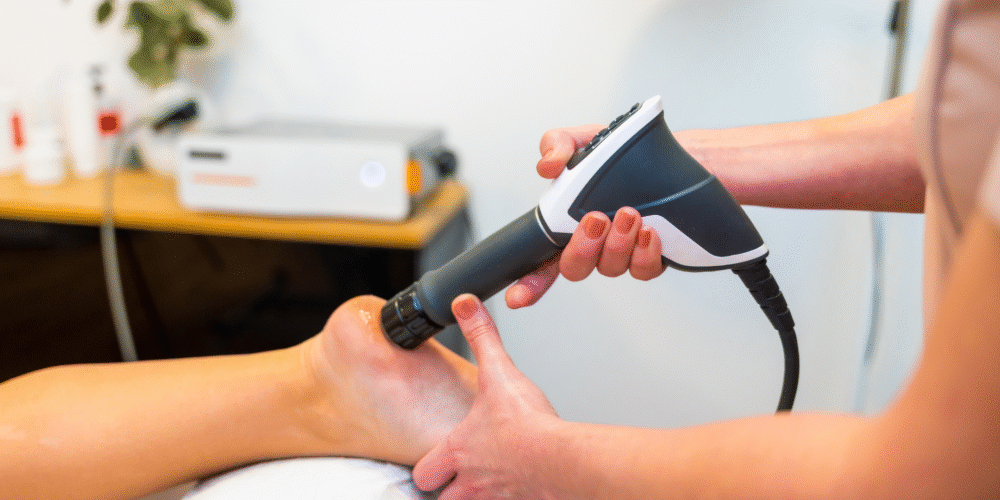
Shockwave Therapy Explained – How It Helps Injuries and Chronic Pain
Shockwave therapy is a non-invasive treatment for pain and injuries. Learn how it works, the conditions it treats, and why it’s becoming popular worldwide.
From elite athletes to everyday patients living with long-term tendon pain, shockwave therapy is becoming one of the most talked-about treatments in modern rehabilitation. It’s safe, non-invasive, and drug-free. Even better, it often helps where other treatments have failed.
Once considered an alternative option, shockwave therapy is now firmly part of mainstream medicine. Physiotherapists, orthopaedic doctors, and sports clinics around the world use it daily to speed up recovery, relieve chronic pain, and support wound healing.
This article explains what shockwave therapy is, how it works, the wide range of conditions it treats, and why it may be the right choice if you’re struggling with slow-healing injuries or stubborn pain.
What is shockwave therapy?
Shockwave therapy uses acoustic energy waves that are applied to specific tissues in the body. These waves travel through the skin to reach muscles, tendons, or ligaments and trigger a natural healing response.
During treatment, a handheld device delivers short bursts of shockwaves to the affected area. These pulses stimulate repair processes by:
- Increasing blood flow to the injured area, improving the supply of oxygen and nutrients.
- Breaking down calcifications that can form in tendons, such as in shoulder calcific tendonitis.
- Stimulating collagen production, which strengthens soft tissues.
- Reducing pain signals sent from the nerves, helping improve comfort.
Unlike surgery or injections, shockwave therapy requires no anaesthetic, has no downtime, and can be performed in a clinic setting.
(And yes — while some people searching “shockwave” are thinking of shockwave file formats or shockwave transformers, in healthcare the term refers to this proven treatment for chronic pain and injuries.)
Conditions treated with shockwave therapy
Shockwave therapy is versatile. It can treat both acute injuries (like sports trauma) and chronic conditions that have persisted for months or years.
Sports & Injury Recovery
- Delayed healing fractures (non-union or stress fractures)
- Muscle strains and sprains
- Ligament injuries such as ankle or knee sprains
- Overuse injuries in athletes including runners and footballers
- Scar tissue adhesions after surgery or significant injuries
Wound & Tissue Healing
- Diabetic foot ulcers that are slow to close
- Pressure ulcers from immobility or long-term care
- Post-surgical wound healing when tissues fail to recover naturally
- Chronic skin injuries with impaired healing
Chronic Tendinopathies
These are some of the most common uses of shockwave therapy:
- Achilles tendinopathy (common in runners)
- Patellar tendinopathy (jumper’s knee)
- Plantar fasciitis (heel pain)
- Tennis elbow (lateral epicondylitis)
- Golfer’s elbow (medial epicondylitis)
- Rotator cuff tendinopathy (shoulder injuries)
- Calcific tendonitis (shoulder calcifications)
Other Conditions
- Myofascial trigger points (muscle knots and tension in the back, neck, and shoulders)
- Shin splints (medial tibial stress syndrome)
- Iliotibial band syndrome (ITB syndrome) in runners and cyclists
By improving circulation and stimulating natural repair, shockwave therapy promotes recovery in tissues that often resist healing.
Benefits of shockwave therapy
Patients and clinicians increasingly turn to shockwave therapy because of its unique advantages:
- Non-invasive – no cuts, no injections, no anaesthetic
- Drug-free – reduces reliance on painkillers or anti-inflammatory medication
- Quick sessions – most last only 15–20 minutes
- Minimal downtime – normal activities can usually resume immediately
- Clinically proven – multiple studies show success in chronic tendon injuries, particularly plantar fasciitis and Achilles tendinopathy
- Cost-effective – avoids expensive surgeries and long rehabilitation programmes
For many, it’s the treatment that finally resolves pain after months of failed physiotherapy or medication.
How many sessions are needed?
The number of treatments depends on the condition. Most patients require 3 to 6 sessions spaced a week apart. Some feel immediate relief after the first session, while others notice gradual improvement as the body heals over several weeks.
A full treatment plan is usually created after initial consultation, tailored to the patient’s injury, age, and lifestyle.
Safety of shockwave therapy
Shockwave therapy is considered very safe when performed by trained professionals. Side effects are usually minor and may include:
- Temporary redness or swelling in the treated area
- Mild discomfort during or after treatment
- Bruising in rare cases
Unlike surgery or long-term medication, the risks are minimal, and recovery is fast.
Shockwave therapy in andrology
Shockwave therapy is not limited to sports injuries and orthopaedics. It is also being studied in andrology, the branch of medicine focused on male health.
Research suggests that shockwave therapy may help improve erectile function by stimulating blood vessel growth and increasing circulation to penile tissue. This makes it an option for men experiencing issues such as:
- Erectile dysfunction (ED)
- Reduced or weaker morning erections (“morning wood”)
- Loss of natural nocturnal erections (“morning glory”)
Online searches such as andrology, andrologist, morning boner highlight the growing interest in male health solutions. Shockwave therapy is emerging as a potential non-invasive treatment in this field.
Who can benefit from shockwave therapy?
Shockwave therapy is suitable for:
- Athletes with chronic sports injuries
- Adults with persistent tendon pain lasting more than three months
- Patients with slow-healing wounds such as diabetic ulcers
- Individuals with muscle tension or myofascial trigger points
- Men experiencing erectile difficulties, as part of a medical treatment plan
It is not usually recommended for pregnant women, patients with clotting disorders, or those with pacemakers.
FAQs about shockwave therapy
Book your shockwave therapy consultation today at Marylebone Diagnostic Centre.
📍 73 Baker Street, London
Contact us


